Here is the Volume 1 of Judo from When you watch something, visit us first! Mr. Toshihiko YAMADA, Director and General Manager of the #Ryotokuji University Staff Judo Team told us why Judo-ka flapping their hands during Judo matches. This is the complete version of Part 1-3 on our YouTube channel.
When you watch Judo matches, you will often see scenes like this. What are the aims of them?
Mr. Toshihiko YAMADA, Director and General Manager of the Ryotokuji University Staff Judo Team, who trained Mr. Wolf Aaron to become an Olympic Gold medalist, told us their aims.
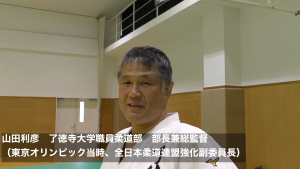
Part 1: What is “Kumite Arasoi”?
When watching a judo match, you often notice that the players are flapping their hands instead of gripping each other. Top-level Judo-ka (athletes) have the ability to throw their opponents when they get into a good Kumite (grip position). They are well aware of this fact, so a “Kumite Arasoi (gripping fight)” occurs, i.e., an attack and defense in which a Judo-ka does not allow his/her opponent to get a good Kumite and at the same time he/she gets a good one.
Now let’s see an example.

White is “Migi-kumi” (his Tsurite = Lifting hand is right), and Blue is “Hidari-kumi” (his Tsurite is left). Both cannot grip their “Hikite” (Pulling hand) each other, but NOW White can! In this brief moment, as White was able to grip Hikite and to have a good Kumite, he could apply Waza (technique).
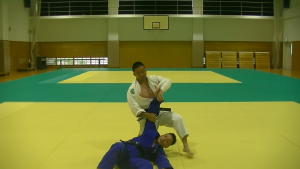
Now let’s see another example.
White does not like to be gripped Hikite by Sode (sleeve) and waves his arm. This time, Blue could have a good Kumite in such brief moment, so he could apply Waza. As these examples, how to try each other to grip a good position is “Kumite Arasoi”.
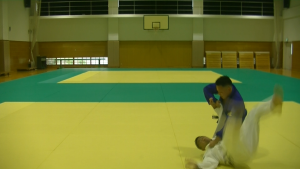
Q:What do you mean by “good Kumite”?
It depends on the style of Judo of each.
White is very good at Katsugi-waza (carrying techniques) such as Seoi-nage, it is easier for him to apply Seoi-nage if he grips Tsurite from below the Blue’s arm. White has to fold his right arm to apply Seoi-nage, so, as I said, it is easier for White to apply Seoi-nage if he grips his right hand from below Blue’s arm rather than from above, because he can get inside.
Of course he is well trained and has the skill to do it from above, but generally it is easier to do it from below. Therefore, he would like to do so. But Blue understands this very well, he grips his Tsurite from the below of White’s arm so that he does not allow White’s Tsurite to be free, and even if it is held from below, a tactic such as applying force from above to prevent it from moving freely is used.
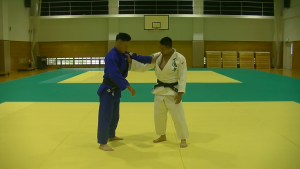
Like this way, Judo-ka will know the inclination of their opponent in advance and be prepared for whichever they like to come from.
Now, about Hikite. In the case of Kenka-yotsu (asymmetrical stance) like them, a distance is created between their bodies. This is the basic stance of Kenka-yotsu. White, who is Migi-kumi, stands with his right foot front, and Blue, Hidari-kumi, stands with his left foot front in the contrary.
From this stance, their Hikite’s are farther from each other than the distance between their Tsurite’s. The tactic of how to grip Hikite for their own advantage occurs. They try each other to grip a good position, or if the opponent is about to get a good grip, he moves his arm to cut it off.
Now, White is in a good enough position as he grips both good Hikite and Tsurite, so he can enter to apply Waza.

Blue understands that White is about to get into a good position, so he waves his arm to cut White’s Tsurite and to reset the situation. This is what goes on in a Kumite Arasoi in general.
If you are not familiar to watching Judo, you may wonder why they just flap their hands and do not grip their Eri (collar) and/or Sode each other, but this is what is going on during a match.
Q:What kind of effects or roles does Tsurite have?
Generally, Tsurite is used to create a desired distance from the opponent. In this case, White is pushing or pulling the opponent with his Tsurite to make the distance from the opponent his desired one. White may use Tsurite to push and to maintain a good spacing when, as foreign players often do, Blue takes his Oku-eri (back collar) and the spacing has been reduced. In such a case, if he has a spacing from the opponent, he can enter inside and apply Waza.
On the other hand, if Judo-ka is forced to be close to the opponent, Judo-ka like White, who specializes in Seoi-nage, is not able to move and apply his Waza. Therefore, Tsurite is generally used to bring the opponent closer or to create a spacing.
Q:You mean Tsurite is used to control the distance from the opponent, right?
Tsurite is used primarily to maintain distance from the opponent, but it is also used to move the opponent up and down, as well as back and forth.
Q:What is the effect or role of grabing Oku-eri which you previously mentioned?
White and Blue are about the same height, but there are many tall Judo-ka overseas, so the first reason is that it is physically difficult for them to grip from below. Tall Judo-ka tend to want to catch their opponents and get close to them. Such players may grab the deep Oku-eri or, in some cases, the back and pull their opponents in, like this. It is easier for them to apply Waza from such position.
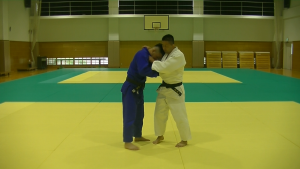
Q:Do they want to make it difficult for their opponent to stand up straight by grabing the Oku-eri and leaning forward?
In addition to that, it also makes it difficult for the opponent to apply Waza.
Q:Does it also have the effect of preventing the opponent’s Waza?
Right. For example, in this situation, Blue cannot move his body and therefore he is not able to apply Waza. Such type of situation can be seen not only with Japanese Judo-ka, but also, and mainly with foreign Judo-ka, and once caught in such situation, the opponents are unable to apply Waza, so, to avoid this situation, it is important to fully utilize Turite as well as Hikite to maintain a proper distance from the opponent.
Q:It means, is the role of Tsurite to make it easier for themselves to apply Waza’s and harder for their opponents to do it?
Yes. Of course, Tsurite is used in other ways, such as when applying Waza, but as far as relating to Kumite Arasoi, it is correct.
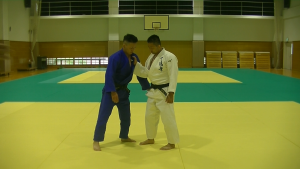
Q:Now, please explain about Hikite.
OK. Let’s see the situation about Ai-yotsu (symmetrical stance) this time, since we have seen the situation of Kenka-yotsu. Even in Ai-yotsu, if Blue grabs Oku-eri and pulls White in, White cannot move his neck and cannot apply Waza, Seoi-nage. It is often seen that White pulls down the Blue’s Tsurite with his Hikite so that his neck and body can turn.
However, if Blue continues with his strategy of grabbing the Oku-eri, this situation will repeat itself. The situation depends on where both parties want to grab the other’s body and where they want to place their own hand.
They are squarely gripping each other in Ai-yotsu of Migi-kumi. In this situation, White wants to lower the opponent’s Tsurite (right hand) using his own Hikite (left hand), while Blue wants to raise his own Tsurite.
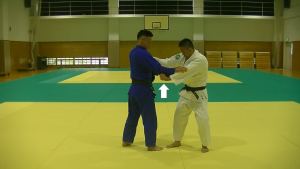
Q:Is it possible to read Judo-ka’s intentions, such as “I want to lean my opponent”, by watching their Kumite Arasoi?
Well, I think it is easy to recognize whether Judo-ka wants to draw the opponent in, or whether he/she wants to make some spacing.
Q:Could you show me an example?
For example, if Blue wants to surely grab White’s Oku-eri, he would grip Mae-eri (front collar) with his Hikite (left hand) first, and by using it, he tries grabbing Oku-eri with his Tsurite (right hand).
Q:This move is intended to bring the opponent closer in, isn’t it?
Yes. Blue’s intention is to bring the opponent close in as well as to make the opponent’s body lower so that White cannot apply his signature Seoi-nage. Before White regains his position, Blue can apply Waza such as Osoto-gari.
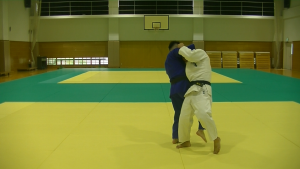
Q:So Blue takes advantage of White’s attempts to regain his position and apply Osoto-gari?
Yes. As White does not like to be out of position, he tries to lower the opponent’s Tsurite with his own Hikite. If White succeeds in lowering Blue’s Tsurite, Blue will try to raise his hand again, and White can use this move to his advantage to apply Waza. This is the tactics that they both want to grip a good position. In the case of two top Judo-ka, they are surely familiar with each other’s Waza, so they are thoroughly prepared for how they should respond to their opponent’s Kumite Arasoi and Waza.
Part 2: What happens in Ai-yotsu?
There are two types of Judo: Migi-kumi (Tsurite = Lifting hand is right) and Hidari-kumi (Tsutrite is left). I will now explain about Ai-yotsu, Migi-kumi vs. Migi-kumi (or Hidari-kumi vs. Hidari-kumi). In the Migi-kumi vs. Migi-kumi situation, Tsurite and Hikite (Pulling hand) of both Judo-ka (athletes) are meshed each other and easy to grapple.
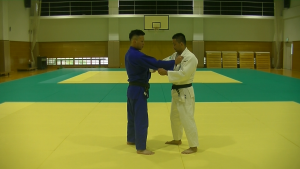
They place their right foot in front, each gripping both Tsurite (right hand) and Hikite (left hand). In the case of Ai-yotsu, these Judo-ka are facing each other, so it is relatively easy to enter to apply Waza. But, if Blue wants to grab Oku-eri (back collar) and pulls White in like this, White pulls down his Hikite to avoid to be broght in because White cannot apply Waza in this situation, and, as a result, Blue is less likely to enter to apply Waza, and Kumite Arasoi continues.

In Ai-yotsu, the difference in physique affects how Judo-ka will conduct because they are facing each other squarely. Although differences in physique do not occur in international competitions (such as the Olympics and World Championships) as well as in some domestic ones which are held in weight classes, some domestic competitions in Japan, such as All Japan Judo Championships and team competitions, are held in open weight, class, so large differences often occur. When there is a large difference in physiques, it is generally easy for the larger Judo-ka to close the distance in Ai-yotsu, as they are facing squarely and grappling each other.
Q:Could you let me see the example of the situation of closing the distance?
Assuming that Blue is a Judo-ka with a good physique, this is the form of grabbing and pulling in the Oku-eri that Blue just showed.
If I (Mr. YAMADA) were to fight White, I would aim for this situation.
*Mr. YAMADA is over 180cm (approx. 6 ft.) and a heavyweight Judo-ka.
As we have explained, Ai-yotsu is easy to grapple, so what we see most often is a squeezing their Hikite’s each other. Since both Judo-ka’s are of approximately the same physiques, in such a case, they do not want to leave the other’s Tsurite free to move, thus resulting in this form of squeezing of Hikite each other. This is a common scene in Ai-yotsu.
Q:Does Judo-ka want to avoid being taken by Tsurite as it is located near the center of gravity of the body?
It is important to control the height of the opponent’s Tsurite, as both Hikite’s are easy to grip. This is a common scene in the lightweight class.
Part 3: What happens in Kenka-Yotsu?
Now, let’s see about Kenka-Yotsu (asymmetrical stance).
At this time, Blue who is Hidari-kumi (his Tsurite =Pulling hand is left), stands with his left foot front, and White, Migi-kumi (his Tsurite is right), stands with his right foot front in the contrary like this, in an asymmetrical stance. In this case, since their Tsurite’s are on the same side, there will be a tactic of whether to grip it from above or below the other’s arm. The key point is whether both parties are aiming to grip from the above or below. For example, if they want to grip from below the other’s arm, a “re-gripping battle” will occur.
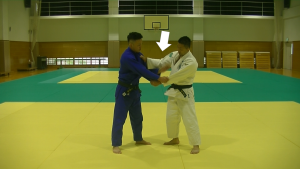
Since there is a distance between both Hikite’s as you can see, how to grip a good position by Hikite is also a common Kumite Arasoi seen in Kenka-yotsu.
Again, it depends on each player’s specialty, but the first point in Kenka-yotsu is whether to hold the Tsurite from above or below, for example, Judo-ka (athlete) like White, who is good at Seoi-nage, wants to hold it from below.
Q:By gripping Tsurite from above (or below) the opponent arm, they intend to put pressure on the opponent’s Tsurite and block his movement?
That is correct.
Q:Why do you take Tsurite first in Kenka-yotsu, unlike in Ai-yotsu (symmetrical stance)?
That is because, as you can see, both Tsurite’s are very close to each other.
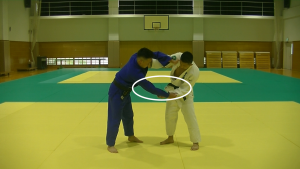
Q:The reason is the difference in distance between Tsurite`s and Hikite’s, isn’t it.
If White try to take Hikite first, he must take one step closer to the opponent. If he does not grip Tsurite then, Blue may grab the desired Tsurite (e.g. Oku-eri =back collar) and close the distance between White and Blue.
Once again, if White goes for Hikite without holding Tsurite, he will be pulled in by Blue, but, if he holds Tsurite first, he can keep his distance like this way even if the opponent tries to pull him in.
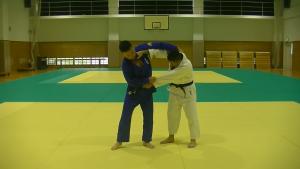
Of course, there is also a strategy of gripping Hikite first, but generally, to grip Tsurite first and then go for Hikite is common in Kenka-yotsu. A tactic often adopted by Judo-ka from overseas of large physiques, is to grasp the opponent’s back deeply rather than the Mae-eri or Oku-eri to further close the distance between them. If Blue does not like this position, he tries to hold White’s Mae-eri like this to keep the distance, for example.
Q:Is it correct to consider that grasping the back is a type of Tsurite?
Yes, you can do so. And when Judo-ka grasp the opponent’s back, and since foreign Judo-ka are very strong, the distance is much closer than when they grip Mae-eri or Oku-eri. Then, as they can close the distance like this, when the opponent tries to move or get up in order to respond, they can apply Waza (techniques) to knock the opponent backward. This is how the tactic is when the back is grasped.
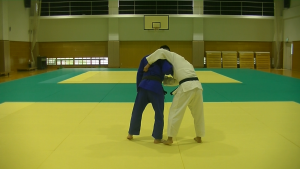
Q:In this case, White is taking advantage of Blue’s motion to try to get up, and throw him backward, isn’t it?
Correct. And for Judo-ka in good physiques, closer and closer when the opponent is, they can transmit their power more and more.
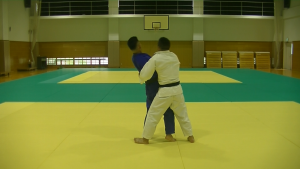
If one Judo-ka’s own strength is stronger than his/her opponent’s, the spacing is also very important in the sense that he/she wants to transmit more power by reducing the distance. On the other hand, Japanese Judo-ka generally have less power than their opponents from overseas, and in many cases they do not want to adopt in a power-to-power contest, for this reason, they often aim to use their Tsurite and Hikite effectively to keep a spacing and enter the gap to apply Waza in an instant.
Share this content:
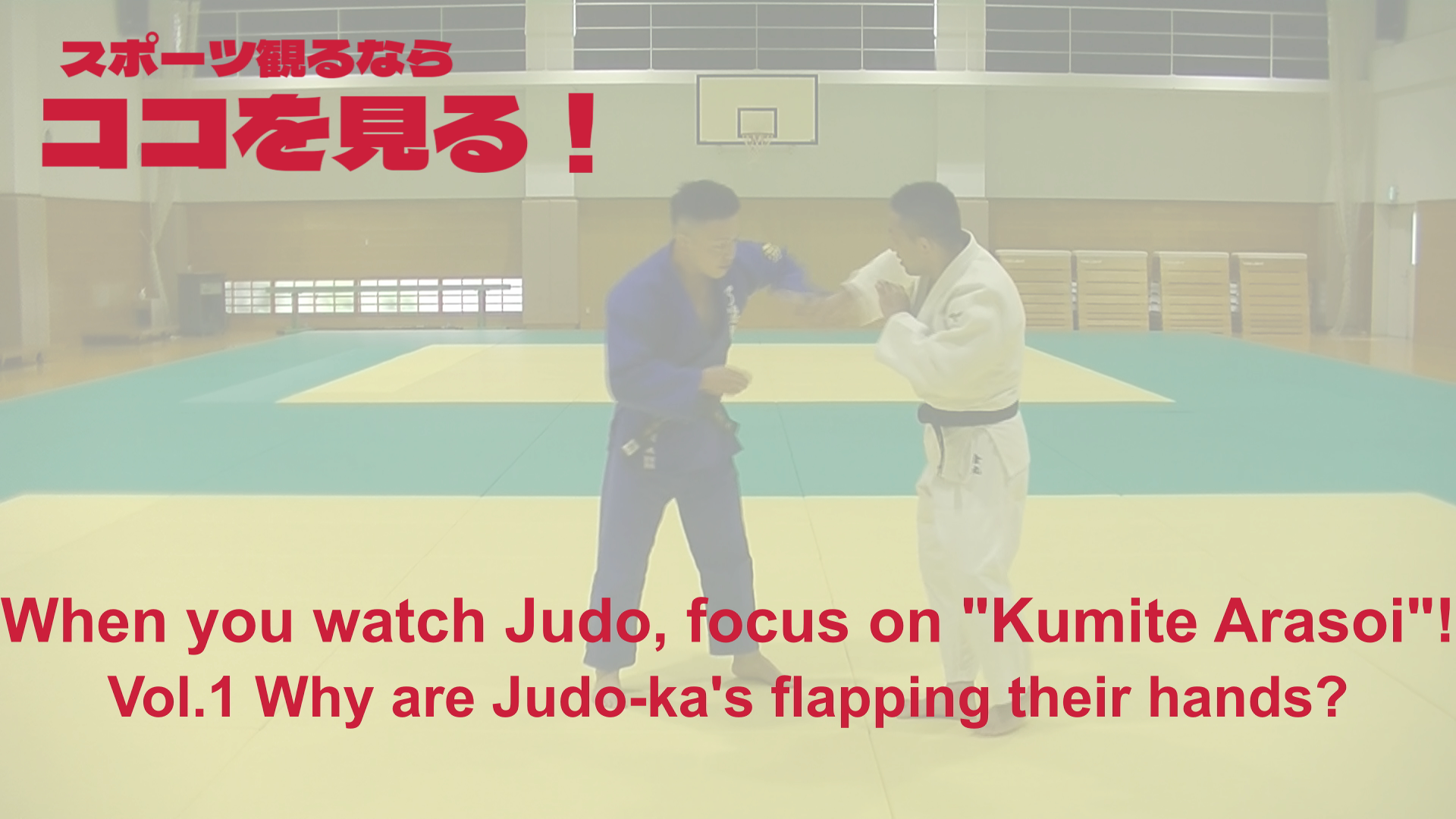
コメントを残す